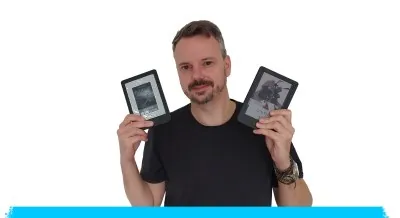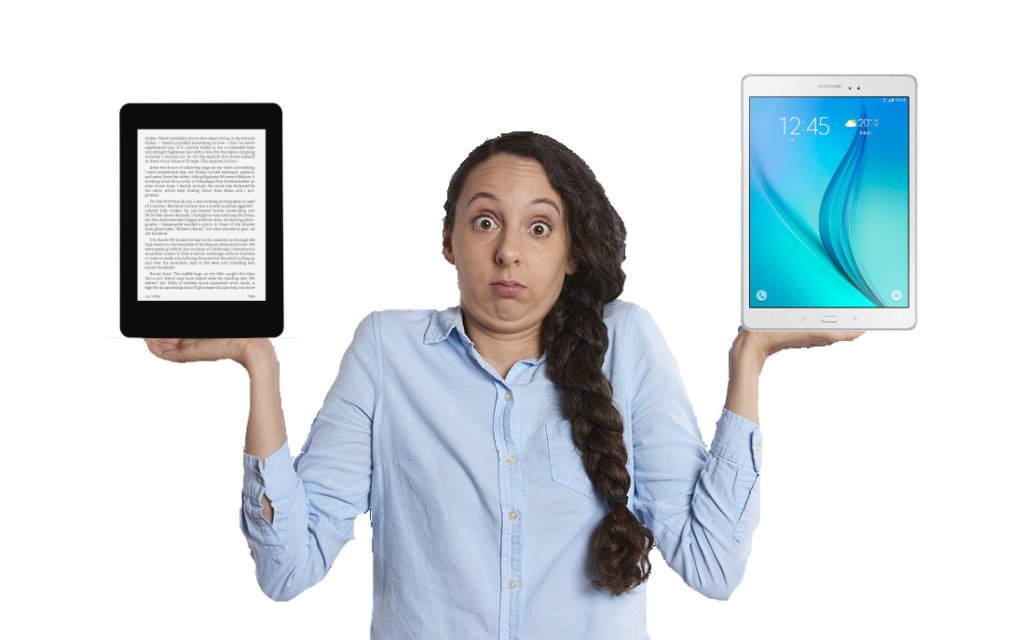
If you want to read your ebooks just about anywhere, you don't have many solutions at hand. You'll have to opt for a e-reader or a tablet, and we'll look at which is the best choice and which reading machine to buy.
Can a tablet be used as an e-reader?
The first thing you need to know is that you can indeed read ebooks on a tablet. There are no restrictions. So, technically, a tablet can be used as a reader if the right application is installed, even if the two machines don't use the same type of screen.
However, it's important to make the right choice, because this device (the e-reader or the tablet) will accompany you in your daily life for many months and years to come.
I reckon you can keep a tablet for around 3 years before it becomes obsolete, and an e-reader for around 5 years. My first e-reader is now over 7 years old!
The choice you make will therefore be an important one, as you'll need to use the device you're about to buy for at least 3 years.
So it's important to make sure it meets your needs.
What's the point of a e-reader?

An e-reader is a digital reading device that displays ebook files on an e-ink screen specially designed for text display.
An e-ink screen is less tiring on the eyes and offers a paper-like display.
The e-reader allows you to adjust a wide range of parameters for displaying the pages of digital books: font size, display font, margins, line spacing, etc.
If you'd like to find out more, read this article to find out how an e-reader works.
E-reader or tablet: what are the differences?
Before making a choice, you'll need to decide on the differences between the e-reader and the tablet (appearance, weight, ease of use, price, etc.).
These differences will help you decide which reading device will be the most appropriate for your use and for digital reading.
With the list of factors to consider when making your purchase, you'll be able to choose a tablet or e-reader easily and efficiently.
Personally, I've come up with 6 criteria that I think are important for reading ebooks on a e-reader or tablet:
- Screen (color or black and white),
- Price,
- Reading comfort,
- Autonomy,
- Night-time reading,
- Weight and size.
So I'm going to take a closer look at the differences between these criteria, and then draw up a summary table of who wins in each category.
Color or black & white screen

This is the device's ability to display color. Even if it's 2023, color e-readers are still only managing to produce something good.
On the other hand, all tablets offer screens that render colors more or less correctly.
If your main use requires color display, a color e-reader is not recommended.
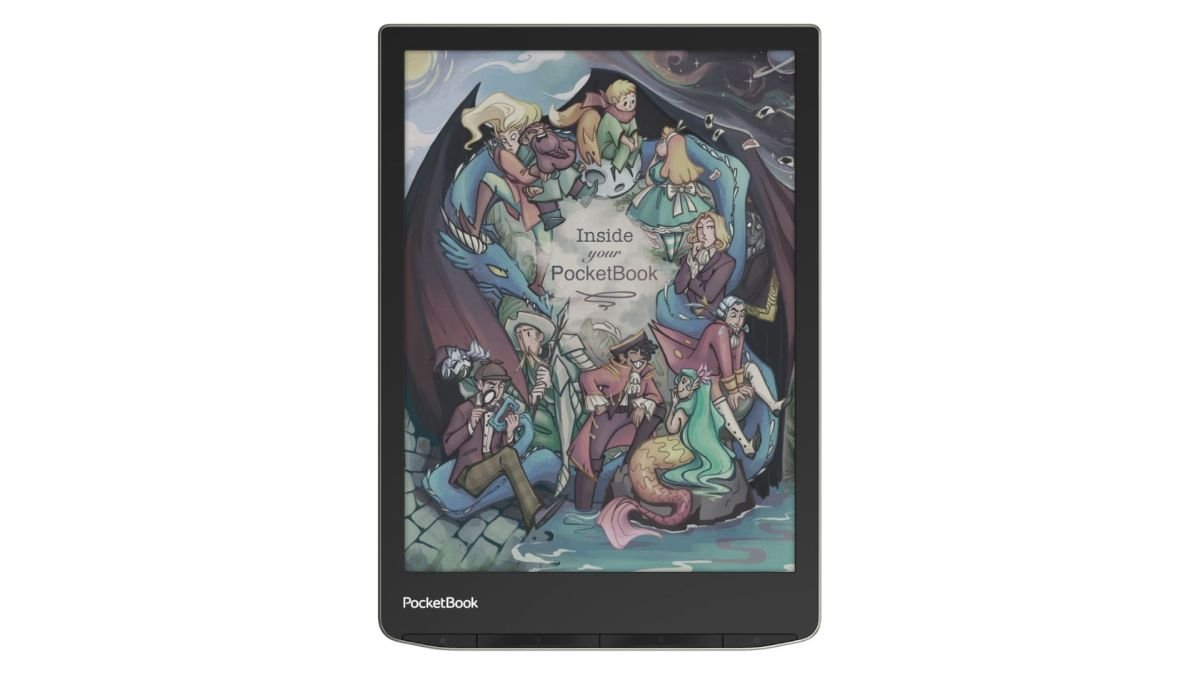
Clearly, if you want to consult a lot of photographs, art reproductions and comics, you'll have to opt for a tablet that displays colors much better than a color e-reader.
If you want to watch videos (films, music videos, documentaries and TV series), the tablet is the only recommended choice.
Price
E-readers are clearly less expensive than touch-screen tablets.
For example, a top-of-the-range e-reader will cost between $200 and $250, whereas a top-of-the-range tablet will easily top $500 or $800.
In short, e-readers clearly have the price advantage, especially as the cheapest e-reader models come in at around 90 - $100. Here are 3 cheap e-readers at the moment:
| Pocketbook Touch Lux 5 | Kobo Nia | Kindle | |
| Image | 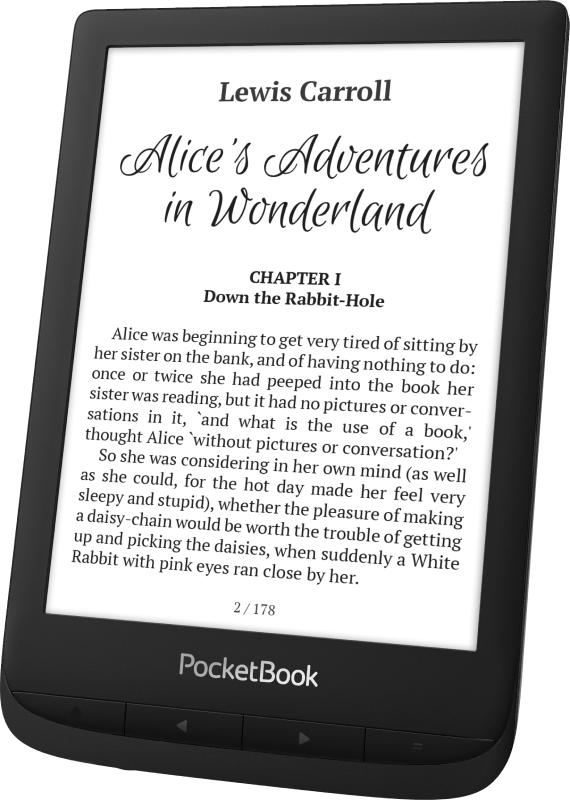 | 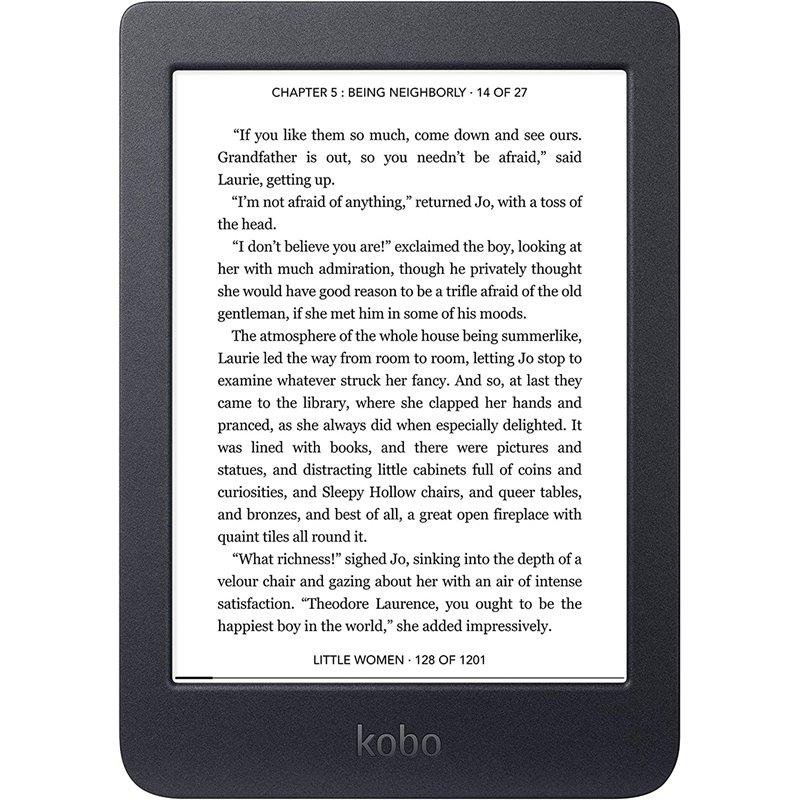 | 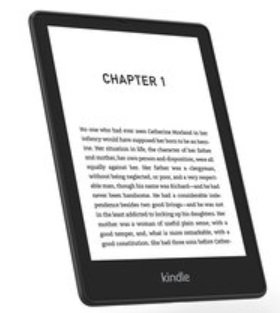 |
| Screen size | 6" | 6" | 6" |
| Resolution | 758 x 1024 pixels | 1024 x 768 pixels | 1448 x 1072 pixels |
| Color | No | No | No |
| Backlight | Yes | Yes | Yes |
| Waterproof | No | No | No |
| Storage | 8 GB | 8 GB | 16 GB |
| Pen / Stylus | No | No | No |
| SD card | microSD memory card slot (up to 32 GB) | No | No |
| Ebook formats | EPUB, PDF, FB2, FB2.ZIP, TXT, DJVU, HTM, HTML, DOC, DOCX, RTF, CHM, TCR, PRC (MOBI), JPEG, BMP, PNG, TIFF | EPUB, EPUB3, PDF, MOBI, JPEG, GIF, PNG, BMP, TIFF, TXT, HTML, RTF, CBZ, CBR | Kindle Format 8 (AZW3), Kindle (AZW), TXT, PDF, EPUB, MOBI, PRC; HTML, DOC, DOCX, JPEG, GIF, PNG, BMP |
| Blue light filter | Yes | No | No |
| Other | Black or Blue color | ||
| Review | ⭐⭐⭐⭐⭐ | Good affordable Kobo eReader ⭐⭐⭐⭐ | Very good ereader at a good price ⭐⭐⭐⭐⭐ |
| Link (where to buy?) | Amazon.com - Official website | Check the price on amazon.com - Official website Kobo.com | $79.99 |
There are, of course, low-cost tablets, so some models are perfectly usable, like the very low-cost one from Amazon.
Reading comfort
If you're going to be reading books most of the time, you'll need to turn to an e-ink e-reader.
This technology enables you to read for long periods without tiring your eyes. E-ink reproduces a smooth, paper-like reading experience.
Tablets, on the other hand, use the same technology you find in televisions. So, if you're reading on a tablet, it's a bit like reading a book on your TV, 1 meter away from your screen!
Holding the tablet so close to your face puts a lot of strain on your eyes and brain.
Battery life
The autonomy of a reading device is several dozen hours, whereas that of a tablet is a few hours (10 or 12 at best).
If I have to recharge my iPad several times a week, I only recharge my Kindle once a month (and even then, it depends on how much I read each day...).
So the advantage clearly goes to the e-reader in this respect.
Night reading & blue light
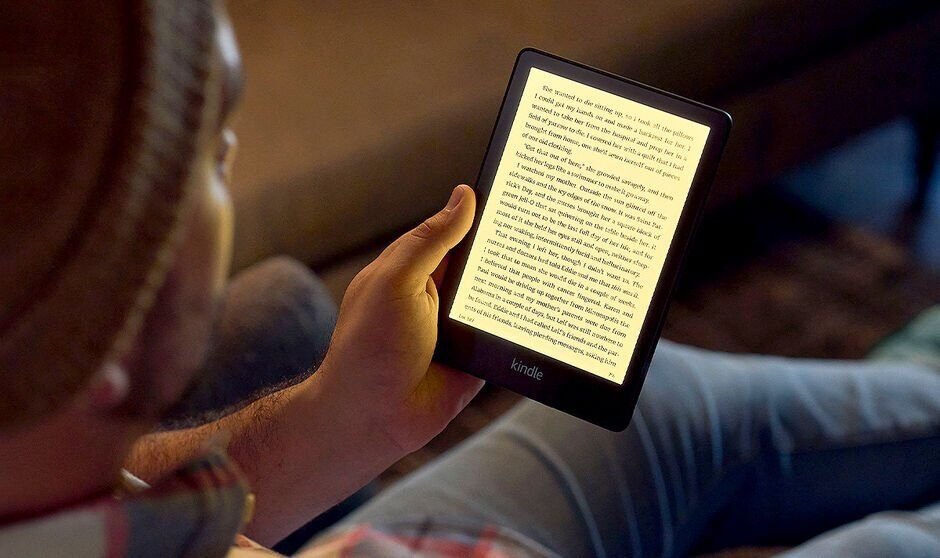
This aspect is very important for me personally, but perhaps not for you.
If you're going to buy a e-reader, look for a version with blue-light filtering.
Unlike tablets, e-reader lights point towards the screen and the light is reflected back to your eyes.
Tablets, on the other hand, use a technique that brings the light from the screen directly to your eyes. It's this technology that quickly makes tablet reading tiring, as your eyes are directly exposed to the direct light.
Here's a rough summary of the principle used by e-readers and tablets (in yellow you see the machine's lighting system):
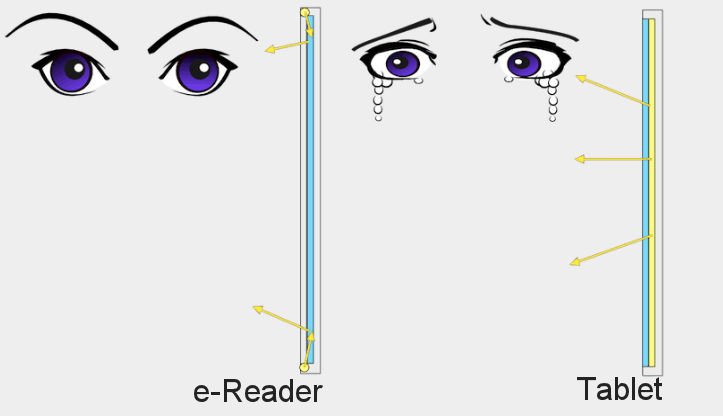
There are now systems for reducing blue light on tablets, such as Blueshade, but I don't find them very convincing.
This type of device used to "filter blue light" is also available on certain e-readers, such as the latest Kindle Oasis or the latest Kobo e-readers, including the Kobo Nia.
I invite you to take a look at our guide to the best e-readers if you're looking for this type of reading machine.
Weight and size
Finally, the weight and size advantage clearly goes to the e-reader.
With its 6-inch screen and minimal weight, a e-reader is as easy to carry as a book. The e-reader is therefore the ideal companion for long journeys.
Conclusion: choose a e-reader or a tablet?
Here is a table summarizing the main differences between e-readers and tablets:
| E-reader | Tablet | |
| Color Screen |  |
 |
| Price |  |
 |
| Reading Comfort |  |
 |
| Battery Life |  |
 |
| Night Reading |  |
 |
| Weight / Size |  |
 |
The e-reader offers greater reading comfort and less eyestrain than the tablet. But the tablet offers more functions (videos) and can display content in color.
The e-reader is therefore the best choice if you intend to read a lot of books.
Once again, and at the risk of repeating myself, the choice depends very much on whether you're going to use the e-reader or the tablet.
But one thing is certain: when it comes to reading comfort, only paper can beat the e-reader.
So if you're mainly going to read with your future machine, the e-reader is the ideal choice.
If you liked this article, consider sharing this page on social network or to someone that could benefit from the information.



